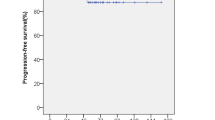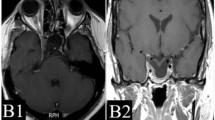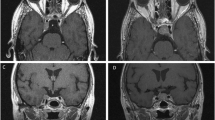Abstract
Objective
The aim of this study was to evaluate the long-term outcomes of initial Gamma Knife radiosurgery (GKRS) for patients with nonfunctioning pituitary adenomas (NFPAs).
Design and methods
This was a single-center retrospective study. Eighty-one patients with NFPAs undergoing initial GKRS were enrolled. The median age was 44.9 years (range, 7.2–75.5 years). The median tumor volume was 2.3 cm3 (range, 0.1–31.3 cm3), and the median tumor margin dose was 13.0 Gy (range, 8–22 Gy).
Results
Tumor shrunk in 63 patients (77.8%), remained stable in 9 (11.1%), treatment failure in 9 (11.1%) during a median follow-up of 67.1 months (range, 11.5–263.9 months). The tumor control rates were 100%, 99%, 95%, and 84%, at 1, 3, 5, and 10 years, respectively. In multivariate analysis, tumor volume (≥4 cm3) and margin dose (<12 Gy) were associated with treatment failure (hazard ratio (HR) = 7.093, 95% confidence interval (CI) = 1.098–45.083, p = 0.040, and HR = 9.643, 95% CI = 1.108–83.927, p = 0.040, respectively). New apoplexy occurred in seven patients (8.6%) after GKRS with a median time of 39.9 months (range, 11.9–166.8 months). In multivariate analysis, tumor volume (≥10 cm3) was a significant risk factor (HR = 10.642, 95% CI = 2.121–53.398, p = 0.004). New hypopituitarism occurred in 14 patients (17.3%). No factors were associated with new hypopituitarism. Four patients (4.9%) developed new or worsening visual dysfunction. No new cranial neuropathy was noted.
Conclusions
In this study, initial GKRS can provide a high tumor control rate, as well as a low incidence rate of complications in NFPAs. GKRS may be an alternative initial treatment for selected NFPAs.






Similar content being viewed by others
References
C. Hoybye, T. Rahn, Adjuvant Gamma Knife radiosurgery in nonfunctioning pituitary adenomas; low risk of long-term complications in selected patients. Pituitary 12(3), 211–216 (2009). https://doi.org/10.1007/s11102-008-0163-x
G. Frank, E. Pasquini, G. Farneti, D. Mazzatenta, V. Sciarretta, V. Grasso, M. Faustini Fustini, The endoscopic versus the traditional approach in pituitary surgery. Neuroendocrinology 83(3–4), 240–248 (2006). https://doi.org/10.1159/000095534
E.F. Chang, G. Zada, S. Kim, K.R. Lamborn, A. Quinones-Hinojosa, J.B. Tyrrell, C.B. Wilson, S. Kunwar, Long-term recurrence and mortality after surgery and adjuvant radiotherapy for nonfunctional pituitary adenomas. J. Neurosurg. 108(4), 736–745 (2008). https://doi.org/10.3171/JNS/2008/108/4/0736
R.F. Dallapiazza, Y. Grober, R.M. Starke, E.R. Laws Jr., J.A. Jane Jr., Long-term results of endonasal endoscopic transsphenoidal resection of nonfunctioning pituitary macroadenomas. Neurosurgery 76(1), 42–52 (2015). https://doi.org/10.1227/neu.0000000000000563.
E. Ferrante, M. Ferraroni, T. Castrignano, L. Menicatti, M. Anagni, G. Reimondo, P. Del Monte, D. Bernasconi, P. Loli, M. Faustini-Fustini, G. Borretta, M. Terzolo, M. Losa, A. Morabito, A. Spada, P. Beck-Peccoz, A.G. Lania, Non-functioning pituitary adenoma database: a useful resource to improve the clinical management of pituitary tumors. Eur. J. Endocrinol. 155(6), 823–829 (2006). https://doi.org/10.1530/eje.1.02298
P. Picozzi, M. Losa, P. Mortini, M.A. Valle, A. Franzin, L. Attuati, C. Ferrari da Passano, M. Giovanelli, Radiosurgery and the prevention of regrowth of incompletely removed nonfunctioning pituitary adenomas. J. Neurosurg. 102, 71–74 (2005).
P. Park, W.F. Chandler, A.L. Barkan, J.J. Orrego, J.A. Cowan, K.A. Griffith, C. Tsien, The role of radiation therapy after surgical resection of nonfunctional pituitary macroadenomas. Neurosurgery 55(1), 100–106 (2004). https://doi.org/10.1227/01.neu.0000126885.71242.d7. discussion 106-107
P. Mortini, L.R. Barzaghi, L. Albano, P. Panni, M. Losa, Microsurgical therapy of pituitary adenomas. Endocrine 59(1), 72–81 (2018). https://doi.org/10.1007/s12020-017-1458-3
S. Sun, A. Liu, Y. Zhang, Long-term follow-up studies of Gamma Knife radiosurgery for postsurgical nonfunctioning pituitary adenomas. World Neurosurg. (2019). https://doi.org/10.1016/j.wneu.2019.01.009
S.C. Bir, R.D. Murray, S. Ambekar, P. Bollam, A. Nanda, Clinical and radiologic outcome of Gamma Knife radiosurgery on nonfunctioning pituitary adenomas. J. Neurol. Surg. Part B Skull Base 76(5), 351–357 (2015). https://doi.org/10.1055/s-0035-1549309
R.M. Starke, B.J. Williams, J.A. Jane Jr., J.P. Sheehan, Gamma Knife surgery for patients with nonfunctioning pituitary macroadenomas: predictors of tumor control, neurological deficits, and hypopituitarism. J. Neurosurg. 117(1), 129–135 (2012). https://doi.org/10.3171/2012.4.Jns112250
M. Losa, M. Valle, P. Mortini, A. Franzin, C.F. da Passano, M. Cenzato, S. Bianchi, P. Picozzi, M. Giovanelli, Gamma Knife surgery for treatment of residual nonfunctioning pituitary adenomas after surgical debulking. J. Neurosurg. 100(3), 438–444 (2004). https://doi.org/10.3171/jns.2004.100.3.0438
J.P. Sheehan, D. Kondziolka, J. Flickinger, L.D. Lunsford, Radiosurgery for residual or recurrent nonfunctioning pituitary adenoma. J. Neurosurg. 97(5 Suppl), 408–414 (2002). https://doi.org/10.3171/jns.2002.97.supplement
K. Zibar Tomsic, T. Dusek, I. Kraljevic, Z. Heinrich, M. Solak, A. Vucinovic, D. Ozretic, S. Mihailovic Marasanov, H. Hrsak, D. Kastelan, Hypopituitarism after Gamma Knife radiosurgery for pituitary adenoma. Endocr. Res. 42(4), 318–324 (2017). https://doi.org/10.1080/07435800.2017.1323913
B.E. Pollock, J. Cochran, N. Natt, P.D. Brown, D. Erickson, M.J. Link, Y.I. Garces, R.L. Foote, S.L. Stafford, P.J. Schomberg, Gamma Knife radiosurgery for patients with nonfunctioning pituitary adenomas: results from a 15-year experience. Int. J. Radiat. Oncol. Biol. Phys. 70(5), 1325–1329 (2008). https://doi.org/10.1016/j.ijrobp.2007.08.018
C.C. Lee, H. Kano, H.C. Yang, Z. Xu, C.P. Yen, W.Y. Chung, D.H. Pan, L.D. Lunsford, J.P. Sheehan, Initial Gamma Knife radiosurgery for nonfunctioning pituitary adenomas. J. Neurosurg. 120(3), 647–654 (2014). https://doi.org/10.3171/2013.11.Jns131757
H.K. Mak, S.W. Lai, W. Qian, S. Xu, E. Tong, M.L. Vance, E. Oldfield, J. Jane Jr., J. Sheehan, K.K. Yau, M. Wintermark, Effective time window in reducing pituitary adenoma size by Gamma Knife radiosurgery. Pituitary 18(4), 509–517 (2015). https://doi.org/10.1007/s11102-014-0603-8
P.U. Freda, A.M. Beckers, L. Katznelson, M.E. Molitch, V.M. Montori, K.D. Post, M.L. Vance, S. Endocrine, Pituitary incidentaloma: an endocrine society clinical practice guideline. J. Clin. Endocrinol. Metab. 96(4), 894–904 (2011). https://doi.org/10.1210/jc.2010-1048
O. Cohen-Inbar, Z. Xu, C.C. Lee, C.C. Wu, T. Chytka, D. Silva, M. Sharma, H. Radwan, I.S. Grills, B. Nguyen, Z. Siddiqui, D. Mathieu, C. Iorio-Morin, A. Wolf, C.P. Cifarelli, D.T. Cifarelli, L.D. Lunsford, D. Kondziolka, J.P. Sheehan, Prognostic significance of corticotroph staining in radiosurgery for non-functioning pituitary adenomas: a multicenter study. J. Neuro-Oncol. 135(1), 67–74 (2017). https://doi.org/10.1007/s11060-017-2520-y
Z. Xu, S. Ellis, C.C. Lee, R.M. Starke, D. Schlesinger, M. Lee Vance, M.B. Lopes, J. Sheehan, Silent corticotroph adenomas after stereotactic radiosurgery: a case-control study. Int. J. Radiat. Oncol. Biol. Phys. 90(4), 903–910 (2014). https://doi.org/10.1016/j.ijrobp.2014.07.013
R. Hasanov, B.I. Aydogan, S. Kiremitci, E. Erden, S. Gullu, The prognostic roles of the Ki-67 proliferation index, P53 expression, mitotic index, and radiological tumor invasion in pituitary adenomas. Endocr. Pathol. 30(1), 49–55 (2019). https://doi.org/10.1007/s12022-018-9563-2
L. Mastronardi, Atypical pituitary adenomas: clinical characteristics and role of Ki-67 and p53 in prognostic and therapeutic evaluation. A series of 50 patients. Neurosurg. Rev. 40(2), 357–358 (2017). https://doi.org/10.1007/s10143-017-0818-z
M.H. Murad, M.M. Fernandez-Balsells, A. Barwise, J.F. Gallegos-Orozco, A. Paul, M.A. Lane, J.F. Lampropulos, I. Natividad, L. Perestelo-Perez, P.G. Ponce de Leon-Lovaton, F.N. Albuquerque, J. Carey, P.J. Erwin, V.M. Montori, Outcomes of surgical treatment for nonfunctioning pituitary adenomas: a systematic review and meta-analysis. Clin. Endocrinol. 73(6), 777–791 (2010). https://doi.org/10.1111/j.1365-2265.2010.03875.x
J.H. Kim, J.H. Lee, J.H. Lee, A.R. Hong, Y.J. Kim, Y.H. Kim, Endoscopic transsphenoidal surgery outcomes in 331 nonfunctioning pituitary adenoma cases after a single surgeon learning curve. World Neurosurg. 109, e409–e416 (2018). https://doi.org/10.1016/j.wneu.2017.09.194
I.J. Pomeraniec, H. Kano, Z. Xu, B. Nguyen, Z.A. Siddiqui, D. Silva, M. Sharma, H. Radwan, J.A. Cohen, R.F. Dallapiazza, C. Iorio-Morin, A. Wolf, J.A. Jane, I.S. Grills, D. Mathieu, D. Kondziolka, C.C. Lee, C.C. Wu, C.P. Cifarelli, T. Chytka, G.H. Barnett, L.D. Lunsford, J.P. Sheehan, Early versus late Gamma Knife radiosurgery following transsphenoidal surgery for nonfunctioning pituitary macroadenomas: a multicenter matched-cohort study. J. Neurosurg. 129(3), 648–657 (2018). https://doi.org/10.3171/2017.5.Jns163069
K.J. Park, H. Kano, P.V. Parry, A. Niranjan, J.C. Flickinger, L.D. Lunsford, D. Kondziolka, Long-term outcomes after Gamma Knife stereotactic radiosurgery for nonfunctional pituitary adenomas. Neurosurgery 69(6), 1188–1199 (2011). https://doi.org/10.1227/NEU.0b013e318222afed
T. Hasegawa, K. Shintai, T. Kato, H. Iizuka, Stereotactic radiosurgery as the initial treatment for patients with nonfunctioning pituitary adenomas. World Neurosurg. 83(6), 1173–1179 (2015). https://doi.org/10.1016/j.wneu.2015.01.054
R. Gopalan, D. Schlesinger, M.L. Vance, E. Laws, J. Sheehan, Long-term outcomes after Gamma Knife radiosurgery for patients with a nonfunctioning pituitary adenoma. Neurosurgery 69(2), 284–293 (2011). https://doi.org/10.1227/NEU.0b013e31821bc44e
J. Sheehan, C.C. Lee, M.E. Bodach, L.M. Tumialan, N.M. Oyesiku, C.G. Patil, Z. Litvack, G. Zada, M.K. Aghi, Congress of neurological surgeons systematic review and evidence-based guideline for the management of patients with residual or recurrent nonfunctioning pituitary adenomas. Neurosurgery 79(4), E539–E540 (2016). https://doi.org/10.1227/neu.0000000000001385
J.P. Sheehan, R.M. Starke, D. Mathieu, B. Young, P.K. Sneed, V.L. Chiang, J.Y. Lee, H. Kano, K.J. Park, A. Niranjan, D. Kondziolka, G.H. Barnett, S. Rush, J.G. Golfinos, L.D. Lunsford, Gamma Knife radiosurgery for the management of nonfunctioning pituitary adenomas: a multicenter study. J. Neurosurg. 119(2), 446–456 (2013). https://doi.org/10.3171/2013.3.JNS12766
C.C. Shen, W.C. You, M.H. Sun, S.D. Lee, H.K. Tsou, Y.J. Chen, M.L. Sheu, J. Sheehan, H.C. Pan, Outcome of partially irradiated recurrent nonfunctioning pituitary macroadenoma by Gamma Knife radiosurgery. J. Neuro-Oncol. 139(3), 767–775 (2018). https://doi.org/10.1007/s11060-018-2925-2
G. Vargas, B. Gonzalez, C. Ramirez, A. Ferreira, E. Espinosa, V. Mendoza, G. Guinto, B. Lopez-Felix, E. Zepeda, M. Mercado, Clinical characteristics and treatment outcome of 485 patients with nonfunctioning pituitary macroadenomas. Int. J. Endocrinol. 2015, 756069 (2015). https://doi.org/10.1155/2015/756069
E.H. Nielsen, J. Lindholm, P. Bjerre, J.S. Christiansen, C. Hagen, S. Juul, J. Jorgensen, A. Kruse, P. Laurberg, Frequent occurrence of pituitary apoplexy in patients with non-functioning pituitary adenoma. Clin. Endocrinol. 64(3), 319–322 (2006). https://doi.org/10.1111/j.1365-2265.2006.02463.x
B.R. Randall, W.T. Couldwell, Apoplexy in pituitary microadenomas. Acta Neurochirurgica 152(10), 1737–1740 (2010). https://doi.org/10.1007/s00701-010-0706-6
C. Briet, S. Salenave, J.F. Bonneville, E.R. Laws, P. Chanson, Pituitary apoplexy. Endocr. Rev. 36(6), 622–645 (2015). https://doi.org/10.1210/er.2015-1042
C.S. Graffeo, M.J. Link, P.D. Brown, W.F. Young Jr., B.E. Pollock, Hypopituitarism after single-fraction pituitary adenoma radiosurgery: dosimetric analysis based on patients treated using contemporary techniques. Int. J. Radiat. Oncol. Biol. Phys. 101(3), 618–623 (2018). https://doi.org/10.1016/j.ijrobp.2018.02.169
J.L. Leenstra, S. Tanaka, R.W. Kline, P.D. Brown, M.J. Link, T.B. Nippoldt, W.F. Young Jr., B.E. Pollock, Factors associated with endocrine deficits after stereotactic radiosurgery of pituitary adenomas. Neurosurgery 67(1), 27–32 (2010). https://doi.org/10.1227/01.Neu.0000370978.31405.A9. discussion 32-23
M. Yamamoto, H. Aiyama, T. Koiso, S. Watanabe, T. Kawabe, Y. Sato, Y. Higuchi, B.E. Barfod, H. Kasuya, Postsurgical salvage radiosurgery for nonfunctioning pituitary adenomas touching/compressing the optic chiasm: median 13-year postirradiation imaging follow-up results. Neurosurgery 85(4), 476–485 (2019). https://doi.org/10.1093/neuros/nyy357
F. Castinetti, J. Regis, H. Dufour, T. Brue, Role of stereotactic radiosurgery in the management of pituitary adenomas. Nat. Rev. Endocrinol. 6(4), 214–223 (2010). https://doi.org/10.1038/nrendo.2010.4
R. Ove, S. Kelman, P.P. Amin, L.S. Chin, Preservation of visual fields after peri-sellar Gamma-knife radiosurgery. Int. J. Cancer 90(6), 343–350 (2000). https://doi.org/10.1002/1097-0215(20001220)90:6<343::aid-ijc6>3.0.co;2-h
T. Abe, M. Yamamoto, M. Taniyama, D. Tanioka, H. Izumiyama, K. Matsumoto, Early palliation of oculomotor nerve palsy following Gamma Knife radiosurgery for pituitary adenoma. Eur. Neurol. 47(1), 61–63 (2002). https://doi.org/10.1159/000047951
Funding
This work was supported by National Key Research and Development Project (grant number: 2017YFC0113700); National Natural Science Foundation of China (grant number: 81800682); the Medical Science and Technology Research Fund Project of Guangdong (grants number: A2018443); the Medical and Health Project of Guangdong (grant number: 20181A011069).
Author contributions
J.Y., Y.L., X.L., T.Q., C.P., J.Z., S.L., Y.H., and M.H. collected and analyszed the data; J.Y. and Y.L. wrote the paper; J.Y. and Y.D. conceived and designed all the experiments; J.Y. and Y.D. directed this work and edited the paper; and all the authors agreed on the final paper.
Author information
Authors and Affiliations
Corresponding authors
Ethics declarations
Conflict of interest
The authors declare that they have no conflict of interest.
Additional information
Publisher’s note Springer Nature remains neutral with regard to jurisdictional claims in published maps and institutional affiliations.
Rights and permissions
About this article
Cite this article
Yu, J., Li, Y., Quan, T. et al. Initial Gamma Knife radiosurgery for nonfunctioning pituitary adenomas: results from a 26-year experience. Endocrine 68, 399–410 (2020). https://doi.org/10.1007/s12020-020-02260-1
Received:
Accepted:
Published:
Issue Date:
DOI: https://doi.org/10.1007/s12020-020-02260-1




